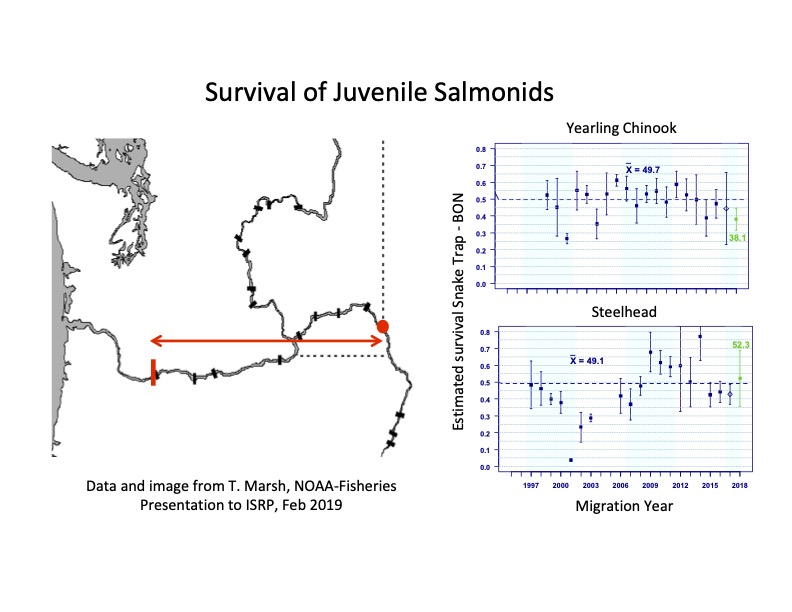forum
library
tutorial
contact

Study: Breaching Dams on Snake River
Would Cost Up to $2.3 Billion
by David Murray
Waterways Journal, January 10, 2020
|
the film forum library tutorial contact |

|
Study: Breaching Dams on Snake River
by David Murray
|
 A study commissioned by the Pacific Northwest Waterways Association (PNWA) has found that if the four lower Snake River dams were removed, the closures would cost up to $2.3 billion over the next 30 years, lead to significant additional carbon emissions that contribute to climate change, and jeopardize health, safety and livelihoods in already fragile local and regional economies.
A study commissioned by the Pacific Northwest Waterways Association (PNWA) has found that if the four lower Snake River dams were removed, the closures would cost up to $2.3 billion over the next 30 years, lead to significant additional carbon emissions that contribute to climate change, and jeopardize health, safety and livelihoods in already fragile local and regional economies.
The study was part of a "war" of dueling studies and statements released ahead of a planned draft environmental impact statement (EIS) to be jointly released in February by the Corps of Engineers, Bonneville Power Administration and U.S. Bureau of Reclamation on the Columbia River system, including the effects of removing the dams.
Dam Removal Calls
For years, environmental groups and local Native American tribes have been calling for the four lower dams--Ice Harbor, Lower Monumental, Little Goose and Lower Granite dams--to be closed and demolished. The groups cite the dams' impacts on federally protected salmon and orcas, which feed on salmon.
The environmentalists' latest argument is that higher water temperatures adversely affect those salmon that use the fish ladders on the river. Water pooled behind dams heats up more than running water, and scientists supporting the dams' removal argue that climate change is exacerbating those heating effects. On October 22, a group of 55 scientists sent a letter to Northwest policymakers arguing that breaching the dams is the only action that could sufficiently cool the river's waters.
On December 4, Joseph Bogaard, executive director of Save Our Wild Salmon, based in Seattle, told the Capital Press, "I don't see any reason why we can't make a transition to a free-flowing lower Snake River and do so in a way that leaves agricultural communities either whole or with additional opportunities."
Losing Barging
The PNWA study was performed by financial and economic consultants FCS Group to assess impacts that would result if barging on the Snake River is lost. The study claims that "significant additional effects" due to the loss of hydropower, irrigation and other authorized uses of the dams would also occur, but the study didn't attempt to capture them.
According to the FCS Group study, breaching the Snake River dams would cause diesel fuel consumption to increase by nearly 5 million gallons per year as barges are replaced by less efficient truck-to-rail shipments. At least 201 additional unit trains and 23.8 million miles in additional trucking activity would be required annually, resulting in increases in CO2 and other emissions by over 1.2 million tons per year. Carbon emissions equivalent to the cumulative emissions generated by a coal-fired power plant every 5-6 years would result.
The Snake River is part of the export corridor for barged Pacific Northwest agricultural products, especially wheat. The study estimates that transportation and storage expenses would likely increase 50 percent to 100 percent for grain suppliers and shippers. At the current reported "break-even" cost per bushel of $5.00, the transportation/storage cost is now about $0.40 per bushel of wheat. These costs could increase by up to $0.80 per bushel if barging were removed as an option, according to the study.
Farm Impacts
If farm subsidies are not increased, the study estimates that more than 1,100 farms could be at risk of bankruptcy. The average regional net farm cash income was only $42,825 in 2017. With wheat prices already down near the break-even point, the study calculates that the federal government would need to increase annual direct payments to farmers by up to $38.8 million to maintain current income levels.
Highway, rail and grain elevator networks would need over $1.6 billion in capital investment. If barging were removed from the Snake River, new infrastructure or costly upgrades would be needed to accommodate the displaced cargo. This includes hundreds of miles of shortline rail track that have been abandoned, new rail, major highway improvements, and retrofits for grain elevators that do not have rail loading capabilities.
"Essential health, sanitation and safety would be jeopardized, along with other public services," the study concludes. That's partly because existing wastewater infrastructure might be damaged or rendered useless if the river level drops, requiring new investments in water intakes, filtration and pumping/transmission systems for a number of cities, counties and major industrial businesses.
"Dam breaching extremists talk about how easy and inexpensive it would be to compensate Washington, Oregon and Idaho businesses and residents if the lower Snake River dams were removed," said PNWA Executive Director Kristin Meira. "We commissioned this study to show federal and state decision makers the real economic and environmental impacts on real people and communities that would result."
The complete study is available on the PNWA website at www.pnwa.net/energy-salmon/.
learn more on topics covered in the film
see the video
read the script
learn the songs
discussion forum
